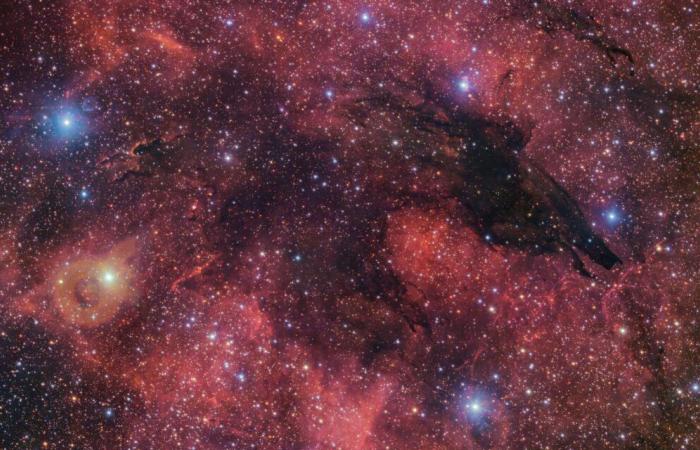La Nasa is not raterate never an occasion to join in the celebration of Halloween and, this year, the European Southern Observatory (ESO) follows suit with a spectacular image of 283 million pixelspixels carried out with the VLT Survey Telescope (VST) at ESO’s Paranal Observatory in Chile. In the words of the ESO press release, it shows a nebula that creates the illusion of a wolf silhouette against a colorful cosmic backdrop.
THE astronomersastronomers amateurs will probably recognize it, because it is linked to SL17 (Sandqvist and Lindroos 17) mentioned in the catalog of dark nebulae which we owe to Aage Sandqvist and KP Lindroos, Swedish astronomers from the Stockholm Observatory, and which was produced in 1976. The Dark Nebula in SL17 is also known as the Fenrir Nebula which, in Norse mythology, is a gigantic wolf, son of the god Loki.
In literature, this Black Wolf Nebula, as it is sometimes called, is also associated with Gum 55, mentioned in The Gum Catalogue, an astronomical catalog of 85 emission nebulae from the southern sky compiled by Australian astronomer Colin Stanley Gum, alas, died at only 35 years old.
This video takes you on a tour of the Black Wolf Nebula, captured in a 283 million pixel image by the VLT Survey Telescope (VST) at ESO’s Paranal Observatory in Chile. Located approximately 5,300 light years from Earth, the cold clouds of cosmic dust create the illusion of a wolf silhouette against a colorful background of luminous gas clouds. To obtain a fairly accurate French translation, click on the white rectangle at the bottom right. English subtitles should then appear. Then click on the nut to the right of the rectangle, then on “Subtitles” and finally on “Automatically translate”. Choose “French”. © ESO/VPHAS+ team. Music: Mylonite – Magnetic Field (Intro)
Recall that emission nebulae are cloudsclouds of gazgaz ionized in the interstellar medium which absorb the lightlight of a starstar hot nearby and re-emit it in the form of colorscolors varied to energiesenergies lower. It is often photonsphotons energy emitted by a young star, in particular the radiation UVUV of an OB type star. Thus, theionisationionisation is generally produced in regions of intense activity where stars are formed such as the Orion Nebula, the Carina Nebula and the Triangle Nebula.
Conversely, the Black Wolf Nebula, which is located around 5,300 light yearslight years of the Earth in the constellation du Scorpionconstellation du Scorpion is therefore part of the dark nebulae which are large interstellar cloudsinterstellar clouds opaque dust which blocks the radiation of starsstars located in the background.
The dust grains heated by this radiation and which make up these nebulae only allow radiation of larger sizes to pass. wavelengthswavelengthslike light infraredinfrared which they emit once heated. THE astrophysicistsastrophysicists study these dust clouds because this is where stars are born and we can therefore test theories about their formation.
The ESO press release concludes by giving the following details:
« The image was compiled from images taken at different times, each with a filter letting in a different color of light. These images were all taken as part of the VST Photometric Hα Survey of the Southern Galactic Plane and Bulge (VPHAS+), which made it possible to study some 500 million objects in our Milky WayMilky Way. Surveys of this type help scientists better understand the life cycle of stars in our galaxygalaxy. The resulting data are made publicly available on the ESO science portal. Explore this treasure trove of data yourself: who knows what other strange shapes you will discover in the darkness? »






